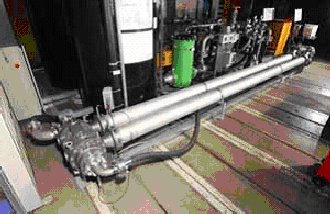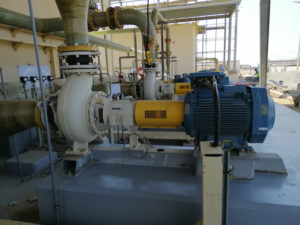New System Reduces Costs of Seawater Desalination
At EUROMED 2004 (30 May - 02 June 2004) in Marrakech, KSB Aktiengesellschaft, Frankenthal, Germany, introduced a new system for use in reverse osmosis (RO) desalination.

"SalTec", the new system for use in reverse osmosis (RO) desalination
The system, called "SalTec", enables energy costs to be reduced compared with conventional turbine solutions through hydraulic power transmission.
The key element is a pressure exchanger in which the energy of the concentrated brine is transferred directly to the raw seawater without mechanical transformation. Losses are avoided in this way and lower energy consumption per cubic metre of desalinated water is achieved.
"SalTec" is designed for RO plants with a capacity of up to 10,000 cubic metres per day and train. The operation of such a plant involves pressures that are higher than the "osmotic pressure" of the water to be desalinated. For desalination, the water is passed along a membrane. Part of the water penetrates the membrane and is removed as desalinated water, or what is known as "permeate".
Pressures of between 60 and 90 bar are required to desalinate seawater. A high-pressure pump provides the inlet pressure that is needed to operate the reverse osmosis process. The remaining concentrated brine is discharged from the pressure vessel at high pressure and passed through the pressure exchanger where its pressure energy is transferred directly to the incoming raw seawater. A booster pump then pumps the latter to the membranes.
An electronic control system permits all the operating conditions of the host RO plant to be monitored, and these can be reacted to by means of pump and pressure exchanger control. For example, it accelerates and slows down the body of water in the pressure exchanger pipes so gently that no pulsations occur when the rotary slide valves of the pressure exchanger are actuated.
KSB is the first manufacturer to offer a complete package such as this for the RO process. All the components are resistant to seawater and are dimensioned in such a way that the life cycle costs of "SalTec" are low. Since August 2003, a test facility has been running at Frankenthal.
Source: KSB SE & Co. KGaA


